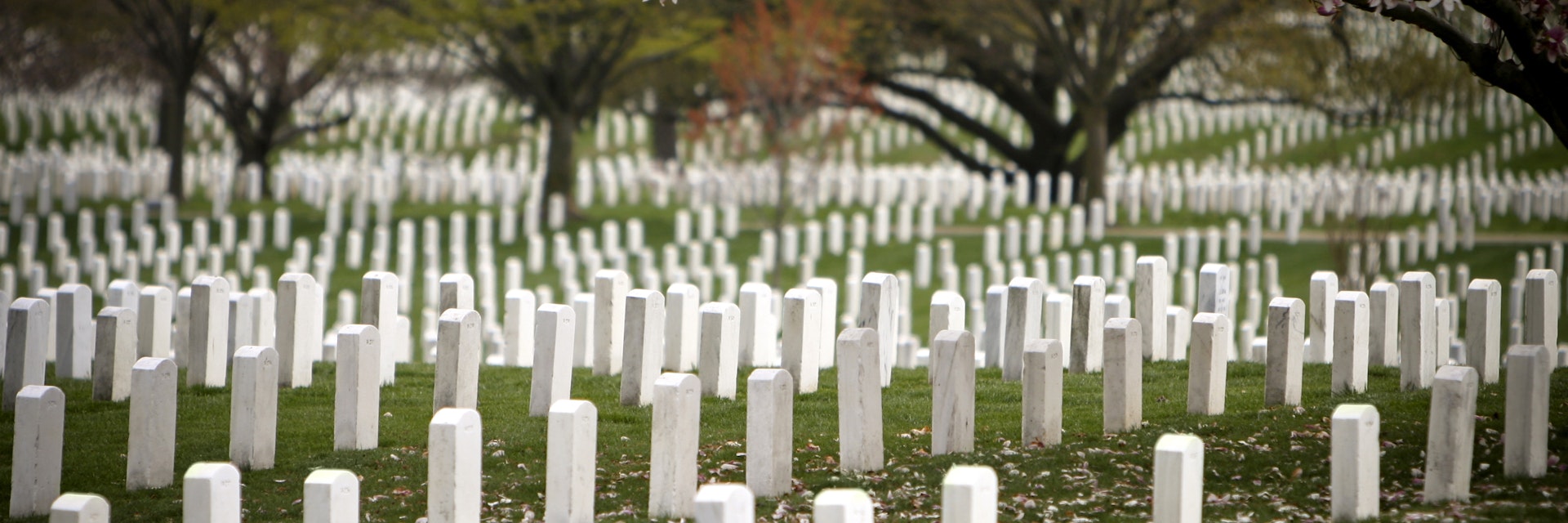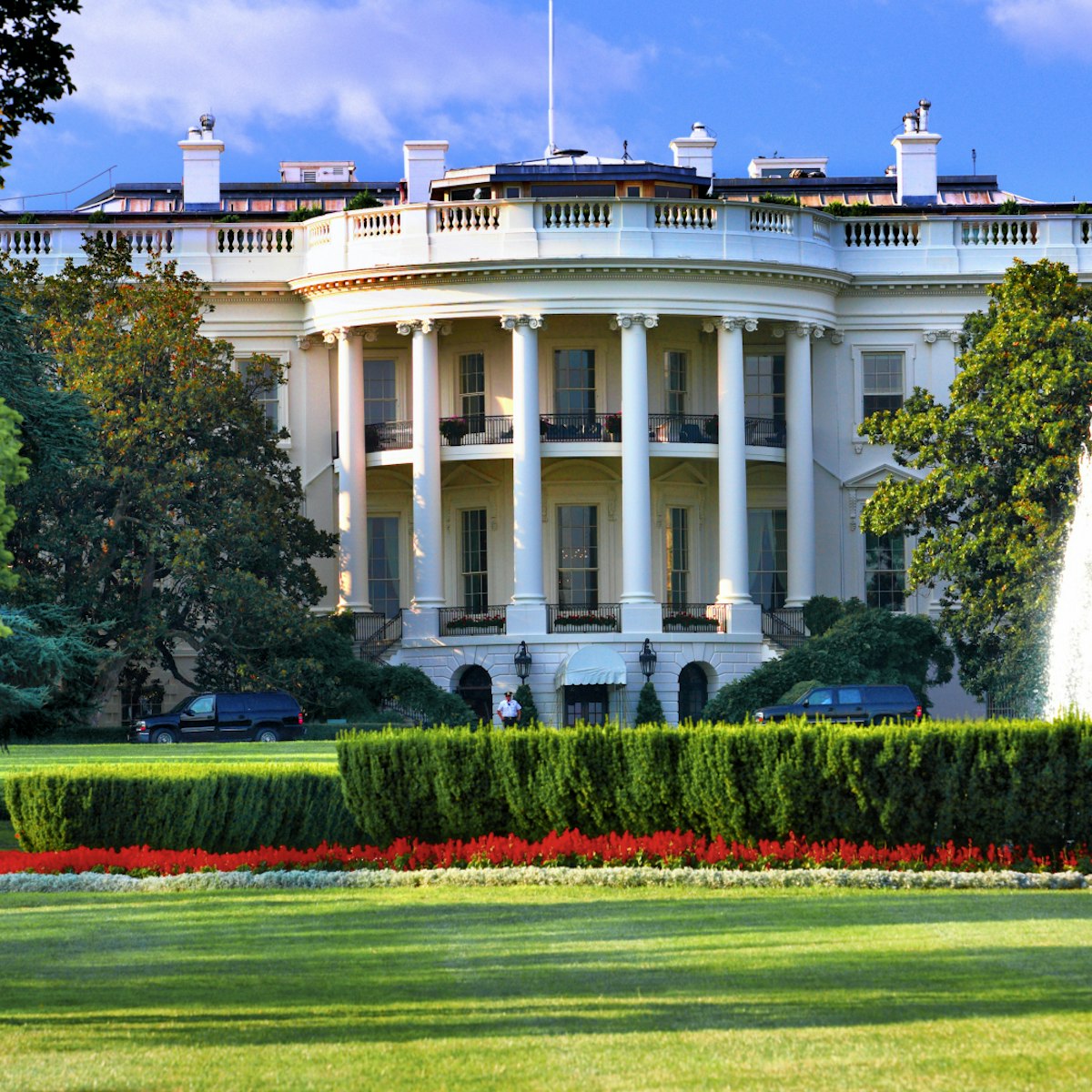Sprawling across hills above the Potomac River in Arlington, Virginia, Arlington National Cemetery is the final resting place for America’s most revered military veterans, along with war correspondents, military nurses, chaplains, and more.
Some 400,000 snow-white gravestones line up in meticulous order, including service members from every one of America’s major wars, from the Revolutionary War to Afghanistan. Here, too, is the eternal flame lit for John F. Kennedy, the Tomb of the Unknown Soldier and Arlington House, once the home of Confederate Gen. Robert E. Lee.
Today, three million people a year come to Arlington to pay their respects.
History of Arlington National Cemetery
George Washington’s adopted grandson, George Washington Parke Custis, established Arlington Estate in 1802. His son-in-law, Robert E. Lee, was living there with his family when, at the start of the Civil War, he joined the Confederate Army, abandoning the property. The U.S. Army seized the land on May 24, 1861, to defend Washington, D.C. Three forts were built on the property during the war, and beginning in 1863, a Freedman’s Village was established for freed and escaped enslaved people.
On May 13, 1864, as local cemeteries ran out of space, Brig. Gen. Montgomery Meigs, Quartermaster of the U.S. Army, ordered Arlington Estate be used as a cemetery. Arlington officially became a national cemetery on June 15, 1864, measuring 200 acres. It was segregated by race and rank until 1948, when President Harry S. Truman desegregated the military.
At first, being buried at Arlington was not considered an honor. It was a place for service members whose families could not afford to bring them home. The first Memorial Day (originally called Decoration Day), was held at Arlington on May 30, 1868. This tradition contributed to its reputation as the premier national military cemetery. The event drew so many people that, in 1873, an amphitheater was built to hold the official cemeteries.
The cemetery has grown from its original 200 acres to its current-day 639, one of the world’s largest national cemeteries. Nevertheless, about 95,000 burial spots remain, and with 22 million living Armed Forces members eligible, there is concern about running out of space. As such, new restrictions of who can be buried at Arlington are being implemented, and land is being acquired to expand the burial site.
How to visit
Start at the Welcome Center, which offers a cemetery overview. Here you can sign up for a shuttle tour that stops at various sites throughout the cemetery, including Tomb of the Unknown Soldier, John F. Kennedy’s gravesite, and Arlington House. You can also walk, though the cemetery’s hills can be challenging.
The Tomb of the Unknown Soldier
The Tomb of the Unknown Soldier, dedicated on November 11, 1921, is a large white sarcophagus that contains three unidentified soldiers: one from each World War and another from the Korean War. An unknown Vietnam vet lay beneath the tomb for more than a decade, until DNA testing identified him in 1998; Air Force 1st Michael Blassie was reinterred in his home state of Missouri at his family’s request.
The tomb is guarded 24/7, rain, shine or snow. The sentinels are rigorously trained volunteers from the 3rd U.S. Infantry Regiment, commonly called the Old Guard. Only the best of the best can apply for this hard-to-get position.
The changing of the guard is a somber ceremony that takes place every hour from October through March and every half-hour from April through September. The sentinel marches 21 steps down the black mat behind the monument’s sarcophagus, waits 21 seconds, then takes another 21 steps back. (Twenty-one represents the highest symbolic military honor: the 21-gun salute.)
The gravesite of John F. Kennedy
After being assassinated in 1963, President John F. Kennedy was laid to rest at the cemetery just east and downhill from Arlington House. His wife, Jacqueline, his brothers Robert and Edward and two children are buried alongside the president. The eternal flame flickering at the site was Jackie’s idea.
All presidents are eligible for burial at Arlington National Cemetery, but to date, only two are here: JFK and William Howard Taft. Also here are boxer Joe Louis, who served in the Army during World War II; Pierre Charles L’Enfant, the architect of D.C. and Supreme Court Justice Ruth Bader Ginsberg.
Arlington House
Robert E. Lee’s former residence has been preserved with some original furnishings and is open for public tours. It was recently reinterpreted to represent the stories of the enslaved people who built the mansion and whom the Lee (and Custis) families kept.
The sections
Arlington is divided into 70 different sections. White Civil War soldiers occupy Section 13, while Section 27 holds African-American soldiers and more than 3,800 freed African Americans (their headstones are inscribed with “civilian” or “citizen” instead of dates and terms of endearment). Sections 18 and 19 contain the graves of Spanish-American War soldiers. Section 60 is the most recent, where Iraq and Afghanistan casualties are buried. See the site map here.
How to get buried here
The requirements to be buried at Arlington are stringent, but most soldiers who died while on active duty and veterans who have been honorably discharged are eligible for burial. Every weekday, up to 30 funerals take place, with a small number of services conducted on Saturdays. Wait times can be long.
How to find a grave
ANC Explorer is a free mobile app that you can use to locate any grave at the cemetery, as well as burial records and front-and-back photos of the headstones and memorials. Directions to find each one are also provided.
Women in Military Service for America Memorial
The neoclassical ceremonial wall just outside the cemetery is the Women in Military Service for America Memorial. Inside you’ll find exhibits, an education center, a theater, and computerized register of military women. The views from the roof, overlooking Arlington National Cemetery’s gravestones to one side, Memorial Bridge and the Washington to another, are astounding.
Getting here and other practicalities
By pubic transport, you can get the blue line Metro to the Arlington Cemetery stop. On the DC Circulator it's the Dupont Circle line.
It's free to enter and is open from 8am. It closes at 5pm October to March and at 7pm from April to September.











